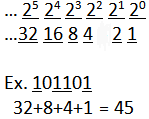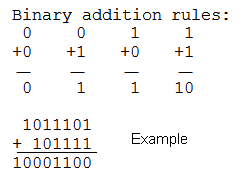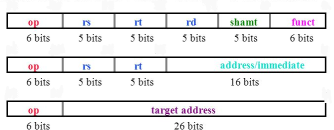
| binary | as a decimal number |
|---|---|
| 00000000 | 0 |
| 00000001 | 1 |
| 00000010 | 2 |
| 00000011 | 3 |
| 00000100 | 4 |
| 00000101 | 5 |
| 00000110 | 6 |
| 00000111 | 7 |
| 00001000 | 8 |
| ... | ... |
| 11111110 | 254 |
| 11111111 | 255 |
123: 00000000000000000000000001111011 -123: 11111111111111111111111110000101Binary number: two digits are 0 and 1 (cf. decimal: ten digits 0..9).


Negate by complementing then adding 1.
8-byte long (64-bit) range from -64E to +64E

123.0: 01000010111101100000000000000000 -123.0: 11000010111101100000000000000000 1.98: 00111111111111010111000010100100 -1.98: 10111111111111010111000010100100 Inf: 01111111100000000000000000000000 NaN: 011111111111111111111111111111118-byte double gives greater range and precision.
Media files (image, sound/audio, video) are mostly (integer) numbers
that represent the color and intensity/brightness of pixels/dots
or pitch/frequency and loudness of sound.
Data files (e.g. spreadsheet, database) might contain these numeric types of data.

| prefix | Greek | English | either | 103n | or | 210n | |
|---|---|---|---|---|---|---|---|
| K | kilo | thousand | 1,000 | 103 | 1,024 | 210 | Ki |
| M | mega | million | 1,000,000 | 106 | 1,048,576 | 220 | Mi |
| G | giga | billion | 1,000,000,000 | 109 | 1,073,741,824 | 230 | Gi |
| T | tera | trillion | 1,000,000,000,000 | 1012 | 1,099,511,627,776 | 240 | Ti |
| P | peta | quadrillion | 1,000,000,000,000,000 | 1015 | ... | 250 | Pi |
| E | exa | quintillion | 1,000,000,000,000,000,000 | 1018 | ... | 260 | Ei |
| Z | zetta | sextillion | ... | 1021 | ... | 270 | Zi |
| Y | yotta | septillion | ... | 1024 | ... | 280 | Yi |
| m | milli | thousandth | .001 | 10-3 | |||
| μ | micro | millionth | .000001 | 10-6 | |||
| n | nano | billionth | .000000001 | 10-9 | |||
Hardware storage capacities:
Installed RAM/(main, primary)memory on a new basic computer: a few GB
Size (storage capacity) of a hard disk drive: maybe 500 GB, or 1 TB
Windows Explorer | C drive (right click) | Properties
USB flash memory thumb drive: 1, 2, 4, 8, 16, 32, 64 GB (note: powers of 2)
Hz hertz: cycles per second. frequency. "ticks" per second. CPU has an internal metronome that pulses
electricity, driving the rest of the circuitry; "speed" of the CPU.
Typical CPU clock rate: 2.2 GHz
bps bits per second: "speed" (bandwidth) of network.
Typical cabled (Ethernet): 100 Mbps or 1000Mbps=1Gbps (Gigabit)
Typical WiFi wireless: a few tens Mbps
Typical Internet access (DSL, cable modem): a few Mbps; fiber optic: few 10s Mbps
s second: ms (milliseconds) μs (microseconds) ns (nanoseconds)
Light travels 300km in a ms, 300m in a μs, 30cm in a ns.
hard disk access: ~10ms. RAM access: ~50ns. Cache access: ~10ns.
ping (connectivity check) to LAN: a few ms; to "far" Internet: up to 500ms
| 1 | K | M | G |
|---|---|---|---|
| liter 1kg | m3 1t | ~50m pool | (100m)3=million m3 ~1/3Pentagon |
| inch | 83' | 15 miles | 15,000 miles |
| second | 16min | 11 days | 31 years |
| ft2 | ~badminton court | 23 acres ~Ellipse DC | 36 miles2 1.5*Manhattan |
| m | km | 1000 km | million km (moon and back) |
| word | 2 pages | Bible |